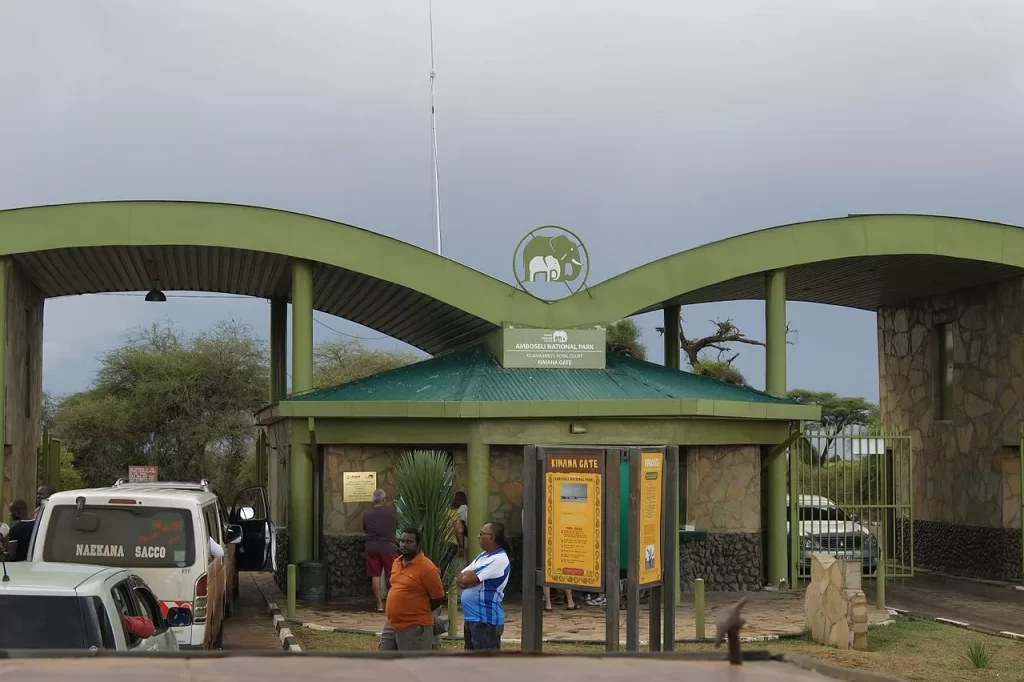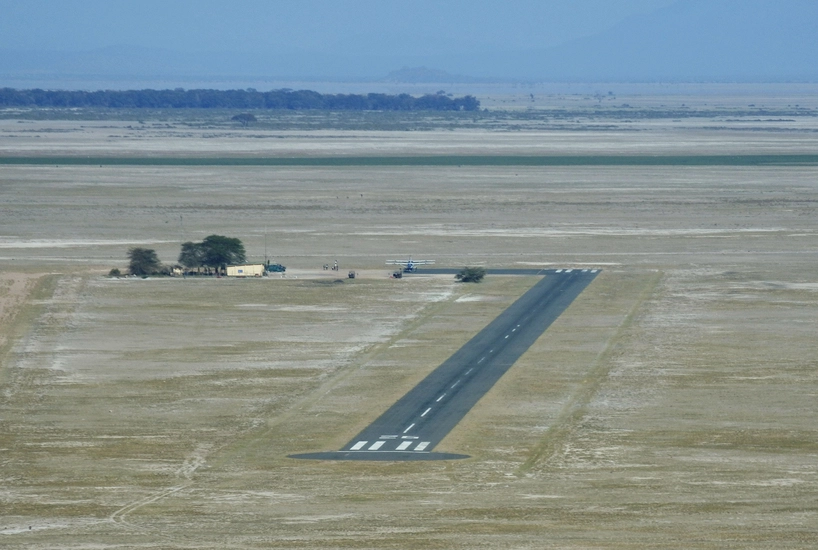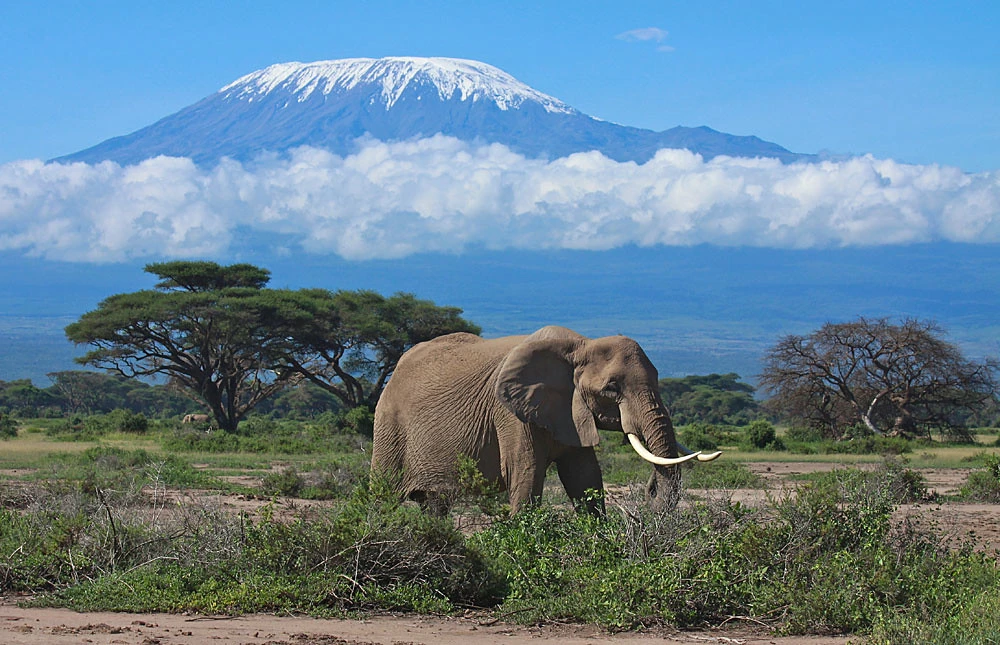There are many national parks in Kenya. Among them is the Amboseli National Park which was previously called the Maasai Amboseli Game Reserve.
Amboseli National Park is found in the Loitokitok district in the Rift Valley region in Kenya. More specifically it is in Kajiado’s south constituency in Kajiado county.
The region covered by Amboseli National Park stretches across the Kenya-Tanzania border. There is a lot that you need to know about Amboseli National Park.

How Big Is The Amboseli?
The Amboseli covers a total area of 392.06km2. This is equivalent to 39206 hectares.
Many Maasai people have settled in the neighboring villages around Amboseli National Park. The word Amboseli was largely influenced by the Maasai which means ‘ salty ground’ in the Maasai vernacular. Apart from the Maasai, other people have settled in the region around the park due to the rich tourism in the area. There have been intentions by the government to rename the park to a reserve so that the local people can access the land. However, this move was challenged in court and was halted. Therefore, the park retained its status as a park.
How Can Tourists Get To The Amboseli?
Tourists can get to Amboseli by using either road transport or air transport.
Road Transport
Amboseli National Park can be accessed through five gates which are the airstrip gate, kulunyiet gate, iremito gate, meshananai gate and Kimana gate. The distance from Nairobi to Amboseli National Park differs depending on the game you are going to use.
Distance From Nairobi To Amboseli National Park

The road routes to Amboseli are well maintained and developed. If you prefer to reach Amboseli National Park using the Isinya gate you will ply a 240-kilometer route from the Magadi road in Nairobi. When using the Kimana gate you will have to go through a 228-kilometer way that goes through Email town to the Mombasa route. While using Meshananai gate, will take approximately 2.5 hours from Nairobi.
There is no restriction on whether to use public or private transport to get to the park. You can use the public service vehicles from Loitoktok town to get to the park. Just as the name Amboseli means ‘ salty ground ‘ the roads in Amboseli can be very dusty. Therefore, it is advisable to use a 4×4 vehicle to avoid any challenges which may arise.
Air Transport

There are many aviation companies which offer daily flights from Jomo Kenyatta International Airport to Amboseli Airport. These aviation companies include AirKenya from Nairobi and Safarilink from Nairobi and Tsavo west. The total cost of using a local flight would be about 250 dollars per person. They can carry 10-12 people at a go, therefore, a full family can travel together. When you arrange to visit Amboseli you must make your bookings earlier to avoid confusion and inconveniences on a set day. Ensure that you carry with you the needed travel documents such as passport, visa and yellow fever vaccination permit. This will enable your visit to go smoothly without disturbances. There are tour operators who can help you with your booking just in case you get stuck.
What Is The Amboseli Known For?
The Amboseli is known for the stunning views of Mount Kilimanjaro and for being the home of the African Elephant. This is just to mention some of the things which make Amboseli very famous.
A large number of tourists from all over the world visit Amboseli National Park every year. Let us go deeper into the things which fascinate the tourists in the Amboseli National Park.
Stunning Views Of Mount Kilimanjaro
Any tourist visiting the Amboseli will get to have a great view of Mt Kilimanjaro. The closeness of Mt Kilimanjaro to the Amboseli National Park makes it very easy to see. You will see the huge size of the Amboseli as it rises to the skies. Mt Kilimanjaro is the highest mountain in Africa and this makes it to be seen very easily. It is with no doubt that to have that fine view of Mt Kilimanjaro, there is no other place to be other than Amboseli. To have that perfect view of Mt Kilimanjaro, you have to view it very early when no clouds are covering it. This is especially possible when the sun is rising. During the day Mt Kilimanjaro is usually covered by clouds therefore it would be difficult to distinguish between the snow peak and the clouds. It can be seen during sunrise and just before sunset.
 Mount Kilimanjaro in the Background.” class=”wp-image-2648″ />
Mount Kilimanjaro in the Background.” class=”wp-image-2648″ />Home Of The African Elephant
Any tourist visiting the Amboseli will be amazed to see a large number of grazing and wandering freely in the Amboseli National Park. These elephants graze closely to each other. The Savannah and the woodlands offer a favorable environment for the elephant to live in. Approximately there are a total of 1600 elephants in the park. The elephants can reach a height of four meters and weigh up to seven tonnes.
The Amboseli is the world’s longest elephant tusks and also the largest elephant in the whole world. The elephants in the park have also been studied by researchers for many years. The African elephant has some distinct features such as long flap ears which enable it to control its temperatures, and a long trunk and tusks.
A large number of elephants in the park has at times resulted in human-wildlife conflict with the nearby villages. However, with the intervention of the Kenyan government and Kenya Wildlife Service, the issue has been settled and solved.
The African elephant faces a great threat from the poachers. This has led to the founding of an organization called Amboseli Trust for Elephants. It was founded to promote the protection of the African elephant which is endangered due to the many cases of poaching in the world. Apart from that the organization also researches the African elephant as it aims at discovering and learning more about the African elephant. The organization partners with the people in the neighboring villages to promote awareness of the conservation of the African elephant.
